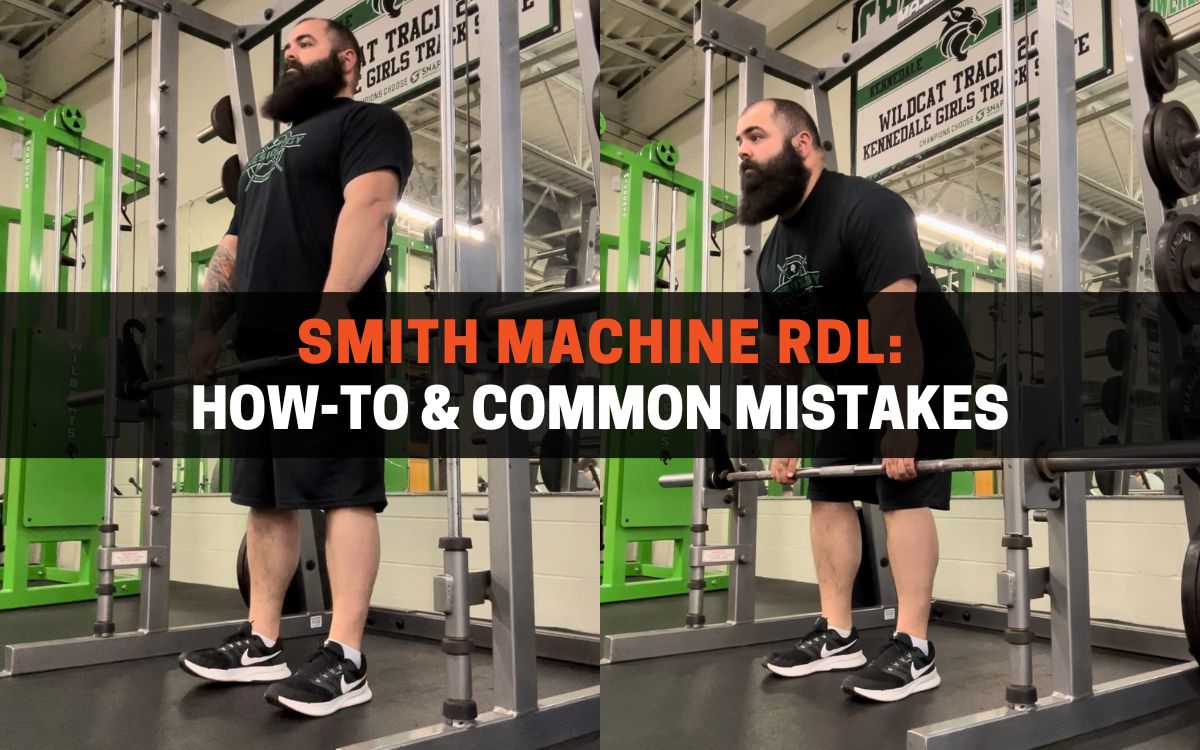If you don’t have access to deadlift platforms, you can use a Smith Machine to reap the strength benefits of the deadlift. It’s also good for those with limited mobility or if you're recovering from injury since the Smith machine bar limits your range of motion.
However, you must tweak your form slightly to avoid injury and maximize your gains.
Read on as I share tips to avoid common mistakes and how to implement them into your workouts.
I wrote about the other best Smith machine back exercises in my full series, so be sure to check them out next.
How To Do Smith Machine Deadlifts
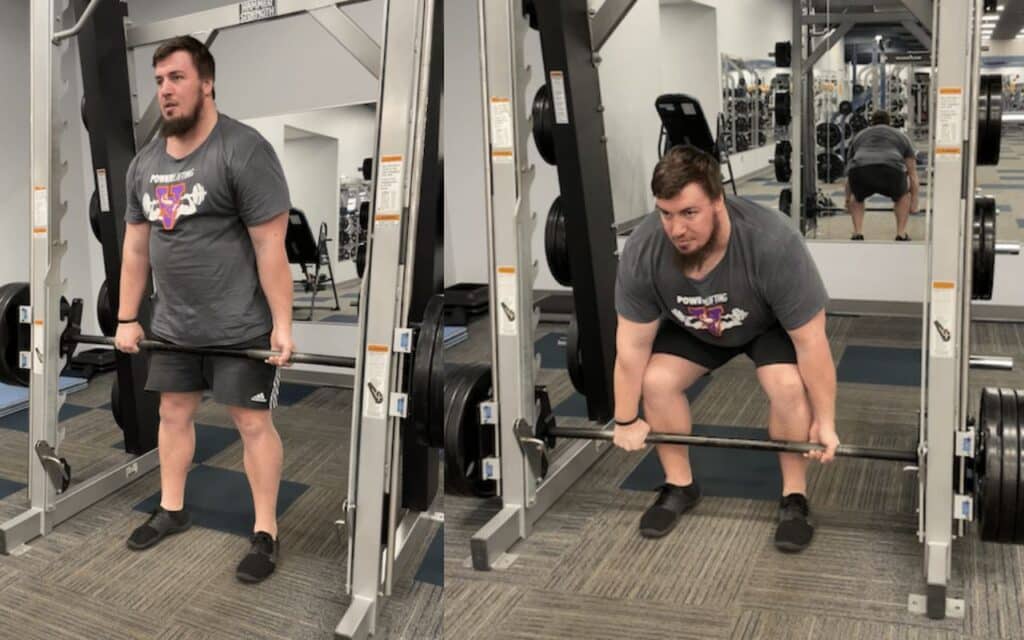
To perform Smith machine deadlifts, you can follow these steps:
- Setup: Set the Smith machine bar as low as it’ll go. On most machines, this will be slightly below knee level.
- Grip and position: Stand in front of the bar, with your hips just about touching it. Keep your arms and legs about shoulder-width apart. Pull your shoulders back and keep your chest up while lowering your body until your hands can reach and grip the bar.
- Lift: Push through your heels to start moving the weight while keeping your shoulders back the entire time. Lockout in a straight standing position, then slowly lower the bar back down.
Pro tip: Avoid bouncing the bar at the bottom. While it can be tempting since it can help you get a few more reps, this usually causes a breakdown in form.
For a more quad-focused exercise, you can also try the sumo deadlift with a Smith machine.
Common Mistakes Doing Smith Machine Deadlifts
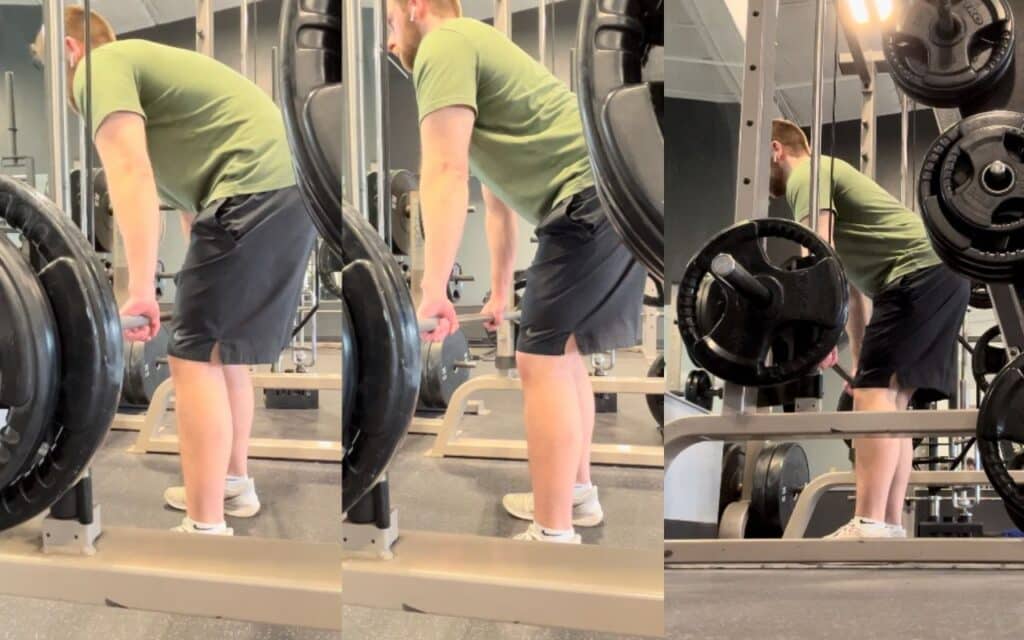
Out of all the exercises, I struggled the most to master deadlifts. They’re complex exercises because there are so many muscles involved you need to focus on. So, to help accelerate your progress and prevent injuries, here are three common mistakes and how to prevent them.
- Rounding your back. As a personal trainer, I’ve seen most clients struggle with their back rounding on Smith machine deadlifts. A good cue to prevent this is keeping your shoulders back and chest up the whole time. Studies show that heavy deadlifts put a force of 5-18 kilonewtons (kN) on the lumbar spine. Repeatedly lifting with poor form can lead to injury over time.
- Standing too far away from the bar. When I first started deadlifting, I was always afraid of the bar hitting my legs. That said, you want to stand close to the bar to get enough leverage on it. Try to find a position where it just grazes your thighs on the way up.
- Hips shooting up too early. This is typically a sign you aren’t using your legs enough to move the weight. It leads to lifting more with your back, which could cause injury.
If you have trouble deadlifting without hitting your knees, check out How To Deadlift Without Hitting Your Knees (5 Tips).
How To Add Smith Machine Deadlifts to Your Workout
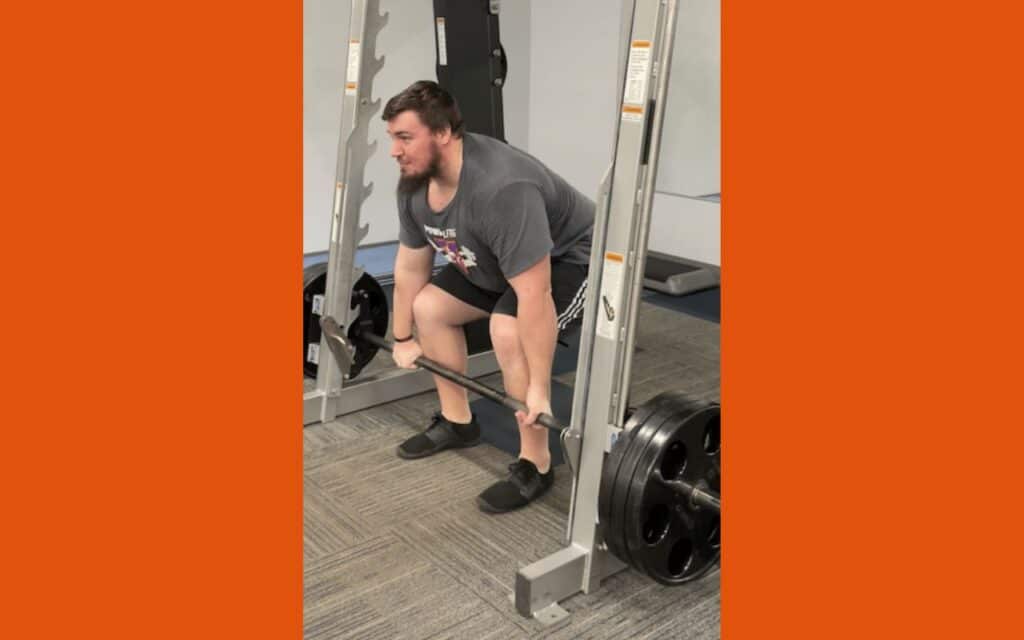
Your training goals will help determine the best way to add it to your workouts.
- If your goal is muscle size (hypertrophy): Perform a higher number of reps at a lower percentage of your one-rep max. Use between 60-80% of your max for sets of 6-12 reps, performing 3-5 sets.
- If your goal is strength: The load should be increased, and the reps should be decreased. Use between 75-90% of your max for sets of 4-6 reps, performing 3-5 sets.
- If you’re prepping for a powerlifting meet or to test your one-rep max: Use 85-100% of your max for sets of 1-3 reps, performing 3-4 sets.
Note that the higher the percentage of your one-rep max used, the longer it’ll take to recover. Studies show that lifting at 80%+ of your one-rep max leads to much more post-workout muscle fatigue. While training for strength, make sure you get enough sleep, eat enough, and plan rest/recovery days.
For more back exercises, check out the Smith machine RDL, row, inverted row, single arm row, and shrug.
Smith Machine Deadlift: Muscles Worked
Many people consider the deadlift to be mostly a posterior chain developer, but many other muscle groups are involved when carrying out the movement.
The muscles worked in the Smith machine deadlift are the:
- Glutes: The glutes are the primary hip extensor during the lockout. They help bring the hips closer to the bar. The hamstrings aid them in this movement.
- Hamstrings: The hamstrings help perform hip extension during the lockout and help bring the hips to the bar. They also help stabilize the knee as the quads extend the knee.
- Erector spinae: The erector muscles run along the outside of the spine. They contract to help you stay upright and keep the spine from rounding in the deadlift.
- Quadriceps: The quad muscles extend the knee in the bottom portion of the movement.
- Latissimus dorsi: The main function of the lats in the deadlift is to keep the bar close to the body. Losing contact between the bar and the body can stress the lower back.
- Trapezius: The traps help maintain the shoulder position in the deadlift. The shoulders should be neutral and slightly depressed (pulled towards the ground).
- Rhomboids: The rhomboids, similar to the traps, help to maintain a proper shoulder and upper back position during the deadlift.
- Abdominals: The abdominals play an important role in stabilizing the spine and preventing hyperextension.
- Forearms: The flexor muscles of the forearm are used to maintain grip on the bar throughout the deadlift.
- Calves: The calves stabilize the body throughout the movement. There is also some slight plantar flexion (toes moving farther away from the shin) of the foot at the bottom of the deadlift.
For a complete guide on all the muscles worked in the deadlift, check out Deadlift: Muscles Worked (Ultimate Guide).
Benefits of Smith Machine Deadlifts
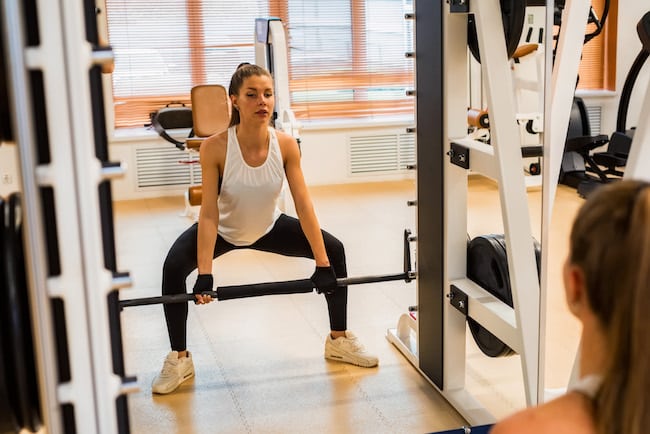
1. Good Option for Beginners
The conventional barbell deadlift can be a difficult movement to perfect. The bottom position is particularly challenging, even for seasoned lifters. Learning how to get in a proper starting position and avoid rounding the lower back can be hard.
Smith machine deadlift form is much easier to learn than barbell deadlift form. This is mainly because the starting position of the movement is easier to get into. The machine also has a fixed bar path, which helps a beginner lifter move the way they should throughout each rep.
2. Builds Muscle Size and Strength
I already discussed the many muscle groups involved in the Smith machine deadlift. But it is worth repeating that the Smith machine deadlift involves the quadriceps, hamstrings, glutes, calves, erector spinae, latissimus dorsi, trapezius, rhomboids, abdominals, and forearms.
Building size and strength in these muscle groups is beneficial for athletic performance and everyday life.
For example, being able to powerfully extend your hips is essential for success in any sporting endeavor. Not only that, but being able to pick things up off the floor is an essential function of daily life.
3. Increase in Bone Density
One of the many benefits of weight training is an increase in bone mineral density. This is especially true of movements that require axial loading, meaning movements that load the trunk. As you load the body, it is forced to respond.
Research has shown that 24 weeks of resistance training utilizing compound movements such as the deadlift can lead to an increase in bone mineral density in both male and female college students.
Since the Smith machine deadlift is also a compound movement (meaning it works multiple muscle groups at the same time), one can assume that it also has a positive effect on bone mineral density.
Drawbacks of Smith Machine Deadlifts
1. Decreased Range of Motion
During a Smith machine deadlift, the bar has to rest on the safety catches instead of the ground. This means you’ll begin the deadlift rep from a higher position than on a standard barbell. This can pose a problem if you want your Smith machine deadlift to carry over to a traditional conventional deadlift.
In a conventional deadlift with a barbell, the hardest part (and the most difficult part from a technical standpoint) is the bottom of the lift. You can stand on a box or plates when using a Smith machine to try and mimic the technique of a regular deadlift, but it still isn’t quite the same.
2. Improper Movement Pattern
In a conventional barbell deadlift, the bar should travel straight up and down. You want to keep the bar close to the body the entire time. This helps to keep the movement safe and prevents unwanted strain on the lower back. A straight bar path also ensures you are not wasting any energy and can lift as much as possible.
On a Smith machine, the bar path is often angled. While it is better to have the bar travel toward yourself than it is for it to travel away from your body, neither bar path is ideal. If you are forced to do your deadlift training on a Smith machine, it may be difficult to unlearn this bar path when returning to a standard barbell.
3. Fewer Muscles Are Worked
As discussed, many muscles are involved in the Smith machine deadlift. However, the Smith machine reduces many of the stabilization requirements of the deadlift. The machine helps stabilize the weight and moves the bar on a fixed path. This makes it so certain muscles, particularly the abdominals, do not have to work as hard to steady the weight.
Earlier, I also spoke about the difference in range of motion when using a Smith machine. Less range of motion means less time under tension for each muscle group. Time under tension is a major factor in building muscle. Less time under tension means less muscle damage and less future muscle growth.
Smith Machine Deadlift Alternatives
The Smith machine deadlift isn’t right for every training scenario. So, here are a couple of my favorite Smith machine deadlift variations.
1. Smith Machine Romanian Deadlift
Those who want more of a hamstring and gluteus maximus (glutes) focus will like the Smith Machine RDL. While the Smith Machine doesn’t allow enough ROM for a stiff-leg deadlift, this will be the next best option. Plus, it’ll help those with less mobility but still want a deadlift variation in their workouts.
How To Do a Smith Machine Romanian Deadlift
- Stand with your feet hip-width apart and a slight bend in the knees.
- Grip the bar with an overhand grip (palms facing toward you), approximately shoulder-width apart. The bar should be at about the middle of your thighs and directly above the middle of your feet.
- Hinge at the hips while bending at the knees slightly, and maintain a straight back by pulling your shoulder blades together as you lower the bar. You should have a slight bend in the knees, but most of the movement should occur at your hips.
- Lower the bar toward the floor until you feel a good stretch in your hamstrings. This should be just below knee height or at the shins.
- Pause for a second at the bottom. Then, bring the hips forward, squeeze the glutes, and straighten the knees slightly to return to the starting position.
- Repeat for the desired number of reps.
Can’t do Romanian deadlifts? Try one of these alternatives to the Romanian deadlift instead.
2. Smith Machine Rack Pull
The Smith machine is a great way to perform rack pulls because it is easy to adjust the bar position. A rack pull allows the body to handle a lot of weight safely. It is also a great exercise if you struggle to lock out your deadlifts and if you want to build a strong mid- and upper back.
How To Do a Smith Machine Rack Pull
- Adjust the safety catches to just below knee height.
- Stand in front of the bar with a hip-width stance.
- Grab the bar with a double overhand or mixed grip just outside your thighs.
- Pull the bar up by simultaneously driving your hips forward and pushing your chest up. Keep the bar as close to your body as possible throughout the exercise.
- Finish the rep by squeezing your glutes and upper back.
- Lower the weight with a slow and controlled motion.
- Repeat for the desired number of reps.
Check out more deadlift progressions for other ideas.
3. Smith Machine Good Morning
A good morning is a great movement for training the hamstrings, glutes, and lower back. It trains many of the same muscles as the Romanian deadlift but does not involve grip strength. This can be a great option for people with arm injuries who still want to train a deadlift-like movement. It is also a good option if your grip is already taxed from other exercises.
How To Do a Smith Machine Good Morning
- Set the bar at about shoulder height, where you’d have it for squats.
- Set the safety catches to waist height so you can set the weight on the safeties if you fail a rep.
- Assume a hip-width stance, bend your knees slightly, and place the barbell across your rear delts.
- Lower your torso toward the floor by pushing your hips backward until your torso is almost parallel to the floor.
- Return to the starting position by squeezing your glutes and bringing your hips forward.
- Repeat for the desired number of reps.
For more, check out my article on The Best 15 Deadlift Alternatives for a Stronger Pull.
How Does a Smith Machine Deadlift Compare to a Barbell Deadlift?
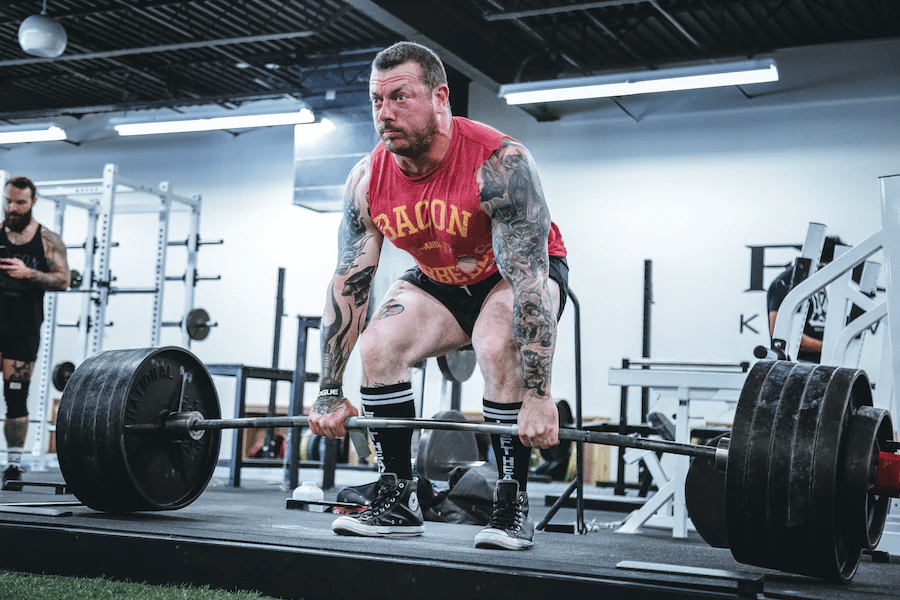
There are three important differences between a barbell deadlift and a Smith machine deadlift: the bar path, whether or not the plates touch the ground, and the muscles worked.
Fixed Bar Path
The fixed bar path on the Smith machine changes how you perform the movement.
On a barbell deadlift, the bar should travel straight up and down. There shouldn’t be any wasted movement forward and back.
On a Smith machine, the bar path is usually angled by seven to 12 degrees. This means that as you deadlift with the Smith machine, the bar will keep getting closer to you. This can cause you to hyperextend at the low back to allow max room for the bar to continue moving upward.
Plates Not Touching the Ground
The plates do not touch the ground on the Smith machine. This affects the starting height of the deadlift. This also means less range of motion, which can affect how your muscles respond to the exercise and could lead to less muscle growth. You can avoid this to some degree by deadlifting off of a box or plates to increase the range of motion.
Muscles Worked
The most important comparison, however, is that both exercises work the same muscles. Both variations of the deadlift work the quadriceps, hamstrings, glutes, calves, erector spinae, latissimus dorsi, trapezius, rhomboids, abdominals, and forearms.
Some of those muscles will be worked slightly less on a Smith machine since the machine stabilizes the weight for you, but it is still a good exercise.
Frequently Asked Questions
Is a Deadlift on the Smith Machine Better Than a Deadlift With a Barbell?
No, most people would not consider a Smith machine deadlift to be better than a barbell deadlift. A barbell deadlift allows more range of motion. Barbell deadlifts also require the body to stabilize the weight, which works the involved muscles more than a Smith machine deadlift.
Who Should Do Smith Machine Deadlifts?
Smith machine deadlifts are best for those with limited equipment or as an accessory movement. Some gyms, like Planet Fitness, only have a Smith machine, so it can be a good alternative to build similar muscles. Those with injuries or limited mobility may also find that using a Smith machine feels better.
References
Ramirez VJ, Bazrgari B, Gao F, Samaan M. Low Back Biomechanics during Repetitive Deadlifts: A Narrative Review. IISE transactions on occupational ergonomics and human factors [Internet]. 2022;10(1):34–46. Available from: https://www.ncbi.nlm.nih.gov/pmc/articles/PMC9837526/
Pareja-Blanco F, Villalba-Fernández A, Cornejo-Daza P, Sánchez-Valdepeñas J, González-Badillo J. Time Course of Recovery Following Resistance Exercise with Different Loading Magnitudes and Velocity Loss in the Set. Sports. 2019 Mar 4;7(3):59.

